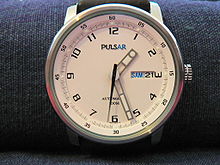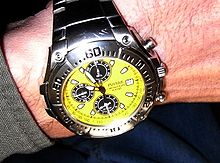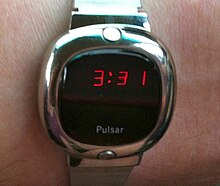Pulsar (watch)

Pulsar is a brand of watch and a division of Seiko Watch Corporation of America (SCA). While Pulsar was the world's first electronic digital watch, today Pulsar watches are usually analog. They generally use the same movements as the lower-end Seikos such as the 7T62 quartz chronograph movement.

History

The first Pulsar was a brand of The Hamilton Watch Company which announced that it was making the watch in early 1970. It was developed jointly by Hamilton and Electro/Data, Inc. In the spring of 1972,[1][2] the first Pulsar watch was marketed by The Hamilton Watch Co. (the parent company, not the Hamilton Watch Division). With an 18-carat gold case, the world's first all-electronic digital watch was also the first to use a digital display – created with light-emitting diodes (LEDs).[3] A button was pressed to display the time. The first Pulsar initially sold for $2100 ($15,800 in 2024 dollars).
The Potpourri segment in the October 1972 issue of Playboy, mentions the first Pulsar – and carries a photo.
In 1975, a digital Pulsar with a built-in calculator (operated with very small buttons) was introduced.[4]
Seiko Corporation acquired the brand in 1978. The Pulsar brand serves as Seiko's mid-grade offering and is positioned above the Lorus brand and below the Seiko brand of watches.
References
- ^ Bertrand Hochet, Antonio J. Acosta, Manuel J. Bellido, Integrated circuit design. Springer, 2002, p.11.
- ^ Christian Piguet, Low-power electronics design. CRC Press, 2005, p.1–10.
- ^ "Smithsonian Invention Centerpieces". Smithsonian Institution.
- ^ E. Fred Schubert, Light-emitting diodes. Cambridge University Press, 2006, p.14
